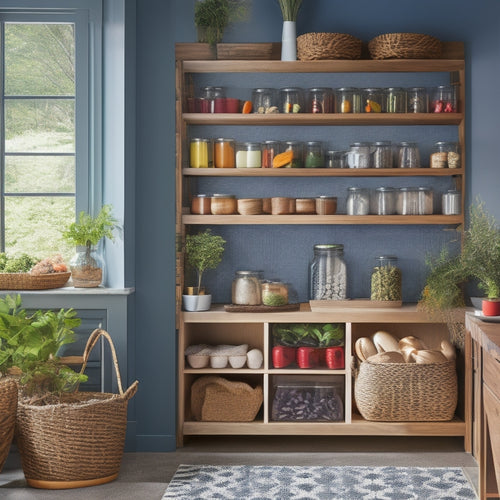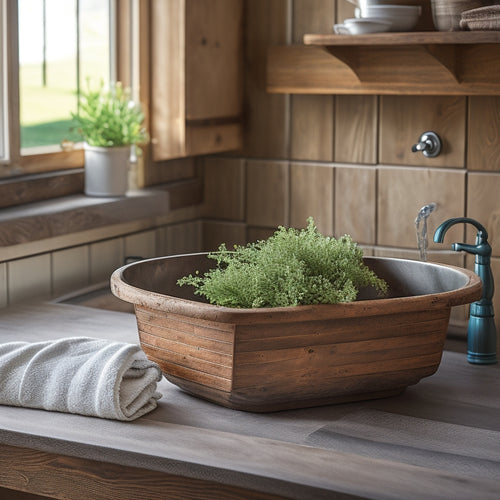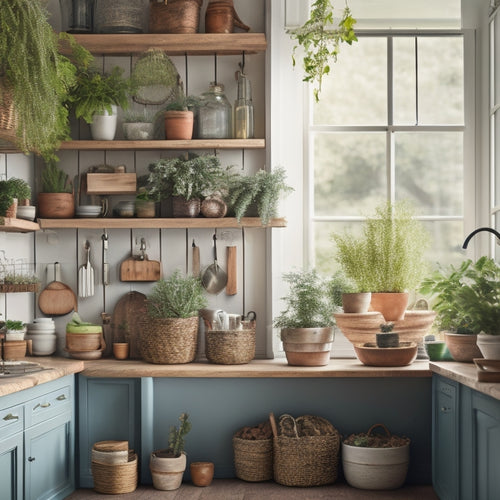
Preserve Like a Pro: Canning Essentials
Share
To preserve like a pro, it's vital to master the fundamentals of canning, including understanding acidity levels, sterilization methods, and storage techniques. A large pot, rack, and acid tester are essential tools, and troubleshooting tips can help identify and rectify common issues. Successful pickling and sweet preservation methods require controlling acidity levels, using the right spices and produce, and following tested recipes. With the right tools, techniques, and knowledge, you'll be well on your way to producing safe, flavorful, and nutritious preserved foods. By combining these essentials with expert tips and creative recipes, you'll access a world of possibilities for preserving seasonal flavors.
Key Takeaways
• Master fundamental canning principles, including acidity levels, sterilization methods, and storage techniques to ensure safe preservation.
• Invest in quality canning tools, including a pressure canner, boiling water bath canner, and jar lifter, to guarantee a successful canning experience.
• Understand the importance of controlling acidity levels, as it prevents spoilage and ensures the growth of beneficial bacteria in pickled products.
• Follow tested recipes and guidelines to achieve pickling perfection, and experiment with creative flavor combinations to elevate your canning skills.
• Properly sterilize and seal jars to prevent contamination and spoilage, and always inspect jars for cracks, chips, or rust before use.
Canning 101: The Basics
A well-stocked canning pantry starts with the right equipment, including a large pot, rack, and acid tester, along with an understanding of the fundamental principles of canning.
To guarantee safe and flavorful recipes, it is important to avoid common beginner mistakes, such as inadequate sterilization or incorrect jar sealing. Troubleshooting tips can help identify and rectify issues, making sure that your canned goods are safe to consume.
Before diving into canning, it is vital to understand the basics, including the importance of acidity levels, sterilization methods, and proper storage techniques.
Pickling to Perfection
Two important components of successful pickling are controlling the acidity level and guaranteeing the pickling liquid reaches a sufficient boil to prevent spoilage. Pickling recipes that incorporate vinegar benefits from its natural acidity, which helps to inhibit bacterial growth.
When combined with the right spices and produce, pickling can result in delicious and crunchy snacks. To achieve pickling perfection, it's vital to follow tested recipes and guidelines to guarantee the pickling liquid reaches a rolling boil, killing off any bacteria that may be present.
Sweet Preservation Methods
Beyond canning and pickling, sweet preservation methods offer a delightful way to savor seasonal flavors and extend the shelf life of fruits and vegetables. Sweet pickling, for instance, involves blending spices, sugar, and vinegar with produce to create a tangy and sweet flavor profile. Jamming techniques, on the other hand, rely on high sugar content to prevent microorganism growth, making them a great way to preserve fruits.
| Method | Description | Benefits |
|---|---|---|
| Sweet Pickling | Blending spices, sugar, and vinegar with produce | Tangy and sweet flavor, extended shelf life |
| Jamming | High sugar content to prevent microorganism growth | Preserves fruits, delicious flavor |
| Freezing | Preserving fruits and vegetables at low temperatures | Retains nutrients, easy to store |
| Dehydrating | Removing moisture from fruits and vegetables | Lightweight, easy to store, crunchy snacks |
Essential Canning Tools
To secure successful canning, it's essential to have the right equipment, as the quality of the tools can significantly impact the safety and quality of the final product.
Investing in high-quality canning equipment, such as a pressure canner, boiling water bath canner, and utensils like a jar lifter and lid wand, will guarantee that your canned goods are properly sterilized and sealed.
Additionally, selecting the appropriate jar for the job is crucial. Choose jars specifically designed for canning, with a smooth, clean rim and a secure lid. Avoid using jars with cracks, chips, or rust, as these can compromise the seal and lead to spoilage.
Beyond the Basics: Tips
A well-stocked pantry and a few expert techniques can elevate your canning game, guaranteeing that your preserved foods are not only safe to eat but also bursting with flavor and texture. To take your canning to the next level, consider the following tips:
| Tip | Description |
|---|---|
| Flavor Infusion | Add unique flavors to your canned goods by infusing them with herbs, spices, or citrus zest. |
| Creative Recipes | Experiment with new recipes that combine unexpected ingredients, like sweet and savory flavors. |
| Acid Balancing | Assure the perfect balance of acidity in your canned goods to preserve flavor and texture. |
Frequently Asked Questions
Can I Use a Slow Cooker for Canning Instead of a Pressure Canner?
'No, it's not recommended to use a slow cooker for canning, as they don't reach high enough temperatures to guarantee safe canning. Instead, use a pressure canner, following tested recipes and guidelines to ensure proper sterilization and food safety.'
How Do I Ensure My Canned Goods Are Shelf-Stable After Processing?
According to the USDA, 1 in 10 canned goods are improperly processed, risking foodborne illness. To guarantee shelf-stability, test acidity levels, verify thermometer accuracy, and store cans in a cool, dark place, inspecting regularly for signs of spoilage.
Are There Any Specific Altitude Adjustments for Canning Recipes?
When canning at high altitudes, it's important to make altitude adjustments to guarantee safety. Increase processing times and pressures to compensate for lower air pressure, following tested guidelines to prevent spoilage and guarantee shelf-stable products.
Can I Reuse Old Lids and Rings for Canning New Batches?
When reusing old lids and rings for canning, verify lid integrity and avoid ring rust to prevent contamination. Always inspect for signs of wear, corrosion, or damage, and replace them if compromised to guarantee safe and successful canning.
How Do I Handle Spoilage or Mold in a Canned Jar After Opening?
Did you know that 1 in 10 canned goods is improperly sealed, risking spoilage? When handling mold or spoilage in a canned jar after opening, remove affected areas, wash thoroughly, and refrigerate or re-can using proper storage and safety precautions to prevent re-contamination.
Related Posts
-

Sliding Pantry Storage Ideas for Renters
If you're looking to optimize your rental kitchen, sliding pantry storage solutions could be your answer. Employ vert...
-

Sink Caddy Organizers for Farmhouse Style Kitchens
Sink caddy organizers are perfect for elevating your farmhouse-style kitchen while keeping it functional. You'll love...
-

Countertop Storage Ideas for Small Kitchens
If you're looking to maximize your small kitchen, creative countertop storage solutions can make a big difference. Em...


